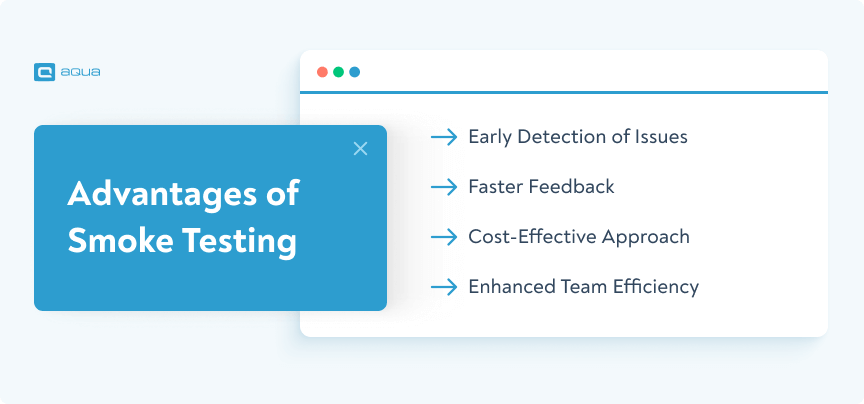What is Smoke Testing?
So how do we define smoke testing in software engineering?
Smoke testing, also meaning “build verification testing,” is your first line of defence against major software issues that determines whether your app or website is ready for the next testing phase. It’s necessary to check the basic functionality of an application. To define smoke testing in software engineering, think of it as a quick health check to ensure the core components are working before you dive into more rigorous testing. By catching the obvious bugs early, you save time and resources, making the entire development process smoother and more efficient. But you need to understand this: smoke testing does not delve into finer details, it is done at a surface level to avoid bugs in the most critical functionalities. So what does it bring to your overall testing efforts, what’s the catch? Let’s explore the advantages of smoke testing together.
Advantages of Smoke Testing
Smoke tests for software offer a range of benefits that can significantly enhance your software development process. Here’s why incorporating smoke testing is a game-changer:
- Early Detection of Issues: By running a quick health check on your software’s core functionalities, smoke testing identifies critical bugs early in the development cycle. This approach saves time and resources that you would otherwise spend on troubleshooting more complex issues down the line.
- Faster Feedback: Smoke tests provide quick insights into the health of your build. This rapid feedback loop allows developers to make necessary adjustments almost immediately, facilitating faster iterations and continuous improvement.
- Cost-Effective Approach: Catching bugs early reduces the cost of fixing them later in the development process. The earlier an issue is identified and resolved, the less expensive it is to address, making smoke testing a cost-effective strategy.
- Enhanced Team Efficiency: By quickly ruling out major problems, smoke testing allows developers and testers to focus on more complex and critical issues. This prioritisation improves team efficiency and accelerates the overall development timeline.

Ready to enhance your testing strategy with smoke testing? Let’s delve into the different types of it before getting you started.
Types of Smoke Testing
Understanding the different types of smoke testing can significantly streamline your software development process. Here’s a detailed look at each type, with their unique characteristics and benefits:
- Daily Build Smoke Tests:
- Purpose: Verify basic functionalities of the software with each daily build.
- Characteristics: These tests are quick and focused, ensuring that core features are operational after each build. They provide immediate feedback to developers, helping maintain stability and reliability throughout the development cycle.
- Sanity Testing:
- Purpose: Focus on specific functionalities or areas of the software to ensure critical components are working as expected.
- Characteristics: Sanity tests are designed to quickly verify whether the most crucial aspects of the software are functional after minor changes or fixes. They are less exhaustive than full regression tests but provide essential validation before more comprehensive testing phases.
- Continuous Integration Smoke Tests:
- Purpose: Validate the integrity of the software system after each integration or build.
- Characteristics: These tests are automated and run continuously as part of the CI/CD pipeline. They ensure that new code integrations do not break existing functionalities and maintain system stability. By catching integration issues early, continuous integration smoke tests support a smooth and reliable deployment process.
Each type of smoke testing plays a vital role in ensuring the quality and reliability of your software throughout its development lifecycle. But who performs these tests? And when is the best time to perform it? Let’s dive into the details together.
In my mind Sanity tests would be "Let's make sure we didn't break anything horribly, just in case" While smoke tests would be "Let's confirm that the core functionalities still work as expected".
When and who performs smoke testing?
You should conduct smoke testing at the initial stages of the software development lifecycle, typically right after a new build is created. It’s also crucial to run smoke tests after major updates or significant changes in the codebase to ensure stability before proceeding with more detailed testing.
As a QA engineer or tester, you are often the one performing smoke tests. Your role involves validating the basic functionality of the application to ensure it’s ready for more in-depth testing. Sometimes, automated tools are used to perform smoke tests, providing consistent and reliable results.
Did you know that a test management system (TMS) can help you run and manage your smoke tests much more effortlessly? TMS can automatically generate smoke tests based on your application’s requirements and recent changes, saving time and ensuring comprehensive coverage. If it is an AI-powered TMS, it can help you prioritise smoke tests based on the likelihood of failure or feature criticality, ensuring important tests are executed first for faster feedback. Additionally, an AI-powered TMS can analyse test results in real-time, quickly identifying issues and potential causes, allowing immediate problem resolution. Automated smoke tests run by the TMS provide consistent and reliable results, eliminating human error and ensuring thorough checks for every build. Furthermore, the TMS generates detailed reports, highlighting smoke test outcomes and offering insights into your application’s health, aiding informed decisions on further testing and development.
And what if we told you there is a solution that will turn your smoke test efforts into a breeze? Introducing you aqua cloud, an AI-powered test solution that has been more than 10 years in the market.
Bringing the German quality to your testing efforts, aqua will streamline your smoke tests in the following ways:
- AI-Powered Test Case Generation:
With aqua, you get test cases generated in seconds from your requirements, saving time and ensuring comprehensive test case management and coverage. - 100% Traceability:
You can track every requirement through to its test case and results, ensuring nothing falls through the cracks. - 100% Test Coverage:
Aqua ensures all aspects of your application are tested, crucial for verifying the basic functionality during smoke tests. - Seamless Reporting:
Integration with Capture provides detailed insights into smoke test outcomes, using screen recordings to quickly identify and resolve issues.
Ready to implement a solution that will take away the pain of testing? Think no more, try aqua cloud now.
Elevate your testing efforts with 200% automation and guaranteed quality
The objective of Smoke Testing
In software development, thorough testing is critical to ensuring a high-quality product. According to a study by Capers Jones
, approximately 85% of software defects are found during complete testing. That means you have to pay enough attention to different testing types, including smoke testing.
Smoke testing, a subset of overall testing, focuses on verifying the basic functionality of an application. The main objective of smoke testing is to ensure that the most crucial features of your application work correctly after a new build or significant changes. By conducting smoke tests, you can quickly detect major issues early in the development process, saving time and resources.
Smoke Testing Use Case: What Happens When You Ignore It
To understand the significance of smoke testing better, let’s look at this example scenario:
Scenario:
A software development team is tasked with deploying a major update to a business-critical enterprise application used for inventory management and order processing.
Challenge:
Due to time constraints and project pressures, the team decides to skip comprehensive smoke testing before the deployment. They proceed directly with the deployment based on unit testing results and initial functional checks.
Issue:
Shortly after the deployment, users begin reporting significant issues with basic functionalities of the application. Key problems include:
- Inability to process orders correctly, leading to customer dissatisfaction and loss of sales.
- Inventory tracking errors causing discrepancies in stock levels and logistics operations.
- User authentication failures, preventing employees from accessing critical business tools.
Impact:
The deployment failure results in:
- Increased operational downtime as IT teams rush to diagnose and fix issues.
- Loss of revenue due to disrupted business operations and dissatisfied customers.
- Damage to the company’s reputation for reliability and service quality.
Resolution:
The development team conducts emergency troubleshooting and hotfix deployments to address critical issues. They subsequently implement rigorous smoke testing protocols for future updates to prevent similar deployment failures.
Want to practically see what happens when you skip smoke testing? Sometimes the best way to understand the critical importance of smoke testing is to experience the consequences firsthand. The scenario below simulates a real-world deployment situation where you’ll face the same pressure and decisions that development teams encounter daily. Step into the shoes of a QA lead and discover why that “quick 30-minute delay” for smoke testing could save your company hundreds of thousands of dollars.
🔥 Interactive Smoke Testing Disaster Simulator (Click to open)
Experience the real-world consequences of skipping smoke testing in this interactive simulation. You're the QA lead for a major e-commerce platform about to deploy a critical update.
📊 Deployment Scenario
🏢 Company: MegaShop Inc.
Annual Revenue: $50M
Daily Users: 100K
Peak Sales: Black Friday Week
🚀 Deployment: Payment System Update
New Features: Mobile wallet integration
Risk Level: High
Deployment Window: 2 hours
Manual vs automated smoke testing
There are 2 main approaches in software testing: automation and manual approach.
Automation testing is getting increasingly popular in software development due to its efficiency and reliability. According to the World Quality Report 2021-2022, automation testing accounts for approximately 52% of all testing activities globally. It shows how widespread automation is in software testing.
When it comes to smoke testing, both automation and manual approaches offer distinct advantages and drawbacks:
- Manual Smoke Testing:
- Pros:
- Greater flexibility to explore edge cases and unexpected scenarios.
- Useful for applications with frequently changing requirements or user interfaces.
- Lower initial setup costs, particularly beneficial for small projects or ad-hoc testing.
- Cons:
- Time-consuming and labour-intensive, especially for large applications or frequent testing.
- Prone to human error and inconsistency in test execution.
- Limited scalability as the application and testing complexity increase.
- Pros:
- Automated Smoke Testing:
- Pros:
- Rapid execution of tests across various configurations and environments.
- Consistent and repeatable results, reducing human error.
- Scalable for large and complex applications, supporting continuous integration and delivery.
- Cons:
- Higher initial setup and maintenance overhead, especially for complex test scenarios.
- Less effective in exploring new functionalities or edge cases without additional scripting.
- Requires expertise in test automation tools and frameworks.
- Pros:
So deciding which one to apply in your smoke testing efforts requires adequate planning and evaluation of your budget, resources and time available.
Process of smoke testing
How do you conduct smoke testing fully? What are the steps? Here is the detailed, step-by-step approach to smoke testing:
- Build Verification:
Verify that the latest build or version of the software is stable and ready for testing. - Identification of Critical Features:
Determine the core functionalities of the application that need to be tested during smoke testing. - Preparation of Test Cases:
Create or select test cases that cover the essential functionalities identified in the previous step. Knowing how to manage test cases effectively ensures comprehensive coverage of critical scenarios. - Execution of Smoke Tests:
Run the selected test cases to ensure that the critical features of the application work as expected. - Results Evaluation:
Analyze the test results to identify any critical issues or failures in the functionality. - Report Findings:
Document and report the outcomes of the smoke tests, highlighting any issues discovered during testing. - Decision Making:
Based on the results, decide whether the build can proceed to more detailed testing phases or if further investigation and fixes are necessary.
Only after following all these steps, you can decide that the product is fully ready for more extensive testing efforts as it is free of critical bugs.
Best practices for smoke testing
Want to ace smoke testing like you never did before? Here are some advanced smoke testing practices you should definitely implement:
- Automate Where Possible:
Implement automated smoke tests to quickly verify basic functionality after each build, ensuring consistency and efficiency. - Prioritise Critical Scenarios:
Focus smoke tests on verifying critical features and high-risk functionalities to quickly identify show-stopping issues. - Use Mocking and Stubs:
Employ mock objects or stubs to simulate dependencies and external systems, allowing isolated testing of core application functionality. - Parameterise Tests:
Parameterise smoke tests to cover multiple configurations and environments, ensuring broader test coverage without duplicating efforts. - Integrate with CI/CD Pipelines:
Integrate smoke tests into your continuous integration and delivery pipelines to automate testing and validate builds before deployment. - Monitor and Analyse Results:
Continuously monitor smoke test results and analyse metrics to detect patterns or trends in failures, facilitating quick resolution of recurring issues. - Maintain Test Suites Regularly:
Regularly review and update smoke test suites to align with evolving application requirements and ensure relevance and effectiveness. - Implement Smart Retry Mechanisms:
Implement intelligent retry mechanisms for smoke tests to automatically rerun failed tests under stable conditions, reducing false positives and ensuring reliable results. - Collaborate and Communicate:
Foster collaboration between development, QA, and operations teams to ensure smoke tests address the right priorities and provide actionable feedback.
By following these best practices, you can streamline your smoke testing processes, improve software quality, and enhance overall development efficiency.
Best tools for smoke testing
There are several tools you can go for if you want to master your smoke testing, ensuring all your critical features function well. We will also be answering the question: what is a smoke test software? Here is a short list of them:
- aqua cloud: aqua revolutionises smoke testing with its AI-powered capabilities, enabling rapid test case generation in seconds directly from your requirements. It ensures 100% traceability and test coverage, providing confidence that all critical functionalities are thoroughly tested. Integrated seamlessly with Capture, aqua cloud offers detailed reporting insights through screen recordings, facilitating quick issue identification and resolution. Experience enhanced efficiency and reliability in your smoke testing process with aqua cloud, empowering your team to deliver high-quality software faster and with no errors
Achieve 100% reliable, error-free software with an AI-powered solution
2. Postman:
Postman is a popular collaboration platform for API development, offering automated testing capabilities to validate APIs quickly and efficiently. While primarily focused on API testing, it provides robust features for automating smoke tests in API-driven applications.
3. Selenium:
Selenium is a widely used open-source tool used as smoke testing software for web application testing, supporting multiple programming languages and browsers. It requires scripting effort for test creation and maintenance, potentially increasing initial setup and maintenance costs.
4. Jenkins:
Jenkins is a leading open-source automation server for continuous integration and delivery, featuring an extensive plugin ecosystem for integrating with various testing and deployment tools. Setting up complex automation workflows may require a steeper learning curve.
These tools cater to different aspects of testing and automation, with aqua standing out for its AI-powered approach to removing the pain of testing by enhancing smoke testing efficiency and effectiveness.
Conclusion
Smoke testing, although often underestimated in its impact, is crucial for robust software testing strategies. As we’ve explored, its early detection capabilities ensure major bugs are caught early, saving valuable time and resources. Tools like aqua cloud exemplify this efficiency, using AI for rapid test case generation, comprehensive traceability, and seamless reporting. By embracing such innovations, you can enhance your testing processes and elevate software quality with each build. As you delve into mastering smoke testing, consider how these insights and tools can transform your approach, ensuring your software meets the highest standards of reliability and performance.


















